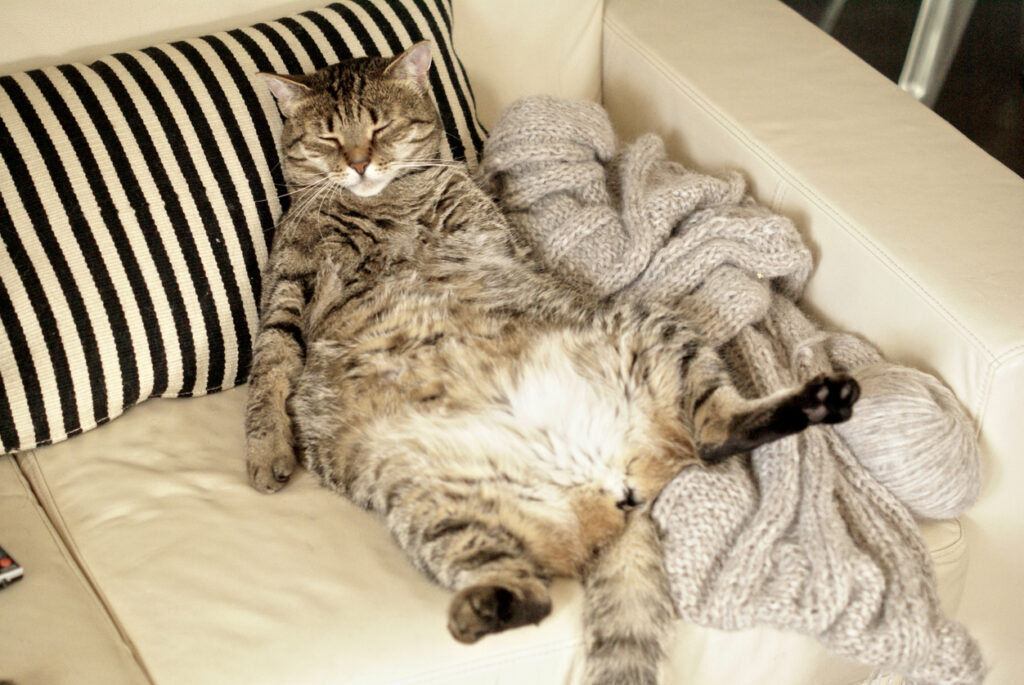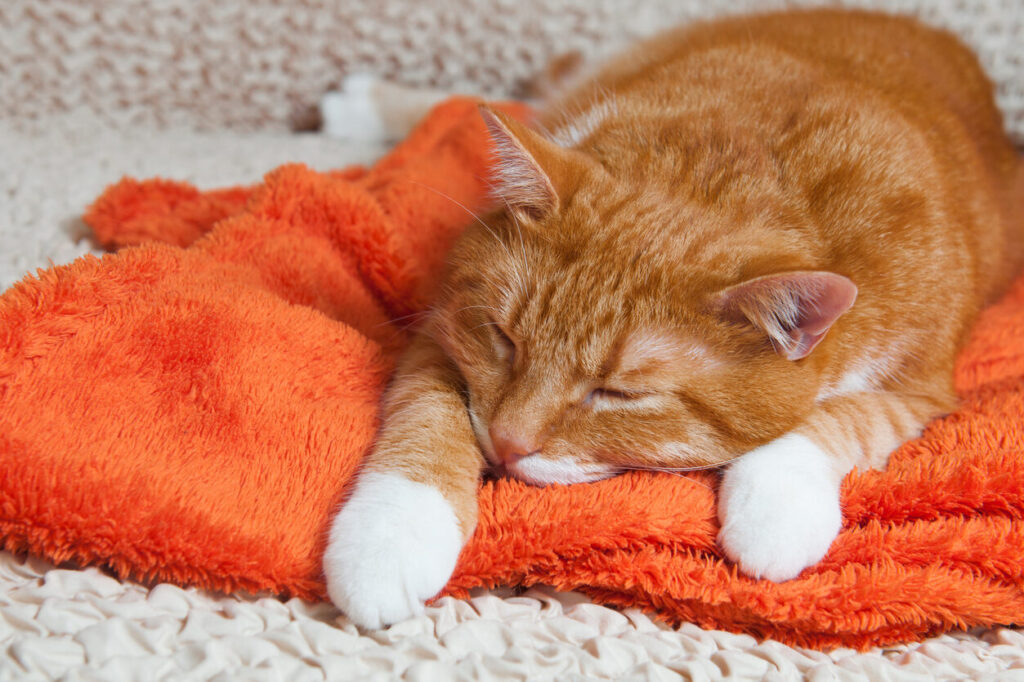1. Your Cat Has Lost Its Waist (And No, It’s Not Just Fluff)

If your kitty looks like a loaf of bread from every angle, it might be time for a closer inspection. Cats are supposed to have a visible waist when viewed from above—kind of like a fuzzy hourglass. If you run your hands along their sides and it feels more like marshmallows than muscle, that’s a red flag. A layer of padding is normal, but if there’s zero definition, your feline might be tipping the scales. Bonus test: can you feel ribs without pressing hard? If not, your cat may be rocking more of a dad bod than is healthy.
It’s easy to confuse fluff with fat (especially with long-haired breeds), but even the floofiest of cats should have some structure. The good news? A few small tweaks in diet and activity can make a big difference. And no, they don’t need to join a CrossFit gym—just more feather wands and fewer snacks. Your cat might not thank you now, but their joints and organs will later. Think of it as a purr-sonal trainer moment.
2. The Dreaded Belly Swing (a.k.a. the Fat Pouch in Motion)

You know the look: your cat runs across the room and their stomach swings like a furry hammock in the wind. While a primordial pouch is normal (yes, cats are supposed to have one), a large, jiggly belly that sways dramatically may mean excess fat. Think of it like the difference between a tote bag and an overstuffed duffel. A pronounced sway can lead to strain on their joints, especially as they age. If your cat has more jiggle than wiggle, it’s time to investigate.
That flabby flap isn’t just cosmetic—it can make jumping, grooming, and playtime more difficult. Obesity in cats can lead to diabetes, arthritis, and even liver disease. If belly drag is happening more often than zoomies, it might be time to check in with the vet. They can tell you what’s normal pouch and what’s padding. Bottom line? That wobble might be cute now, but your cat deserves to leap without the luggage.
3. They’re Out of Breath… After Napping

Sure, cats are the masters of relaxation, but if your furball gets winded from a stroll to the food bowl, it’s a problem. Overweight cats may start panting, breathing heavily, or avoiding movement altogether. If your cat looks like they just ran a marathon after casually hopping onto the couch, take notice. Cats hide illness well, but their stamina doesn’t lie. Struggling with basic activities is a sign their weight is affecting their energy and heart health.
Just like us, when a cat carries extra weight, their whole system has to work harder. It’s not about fat-shaming—it’s about helping them feel better. You want a spry, sassy sidekick, not one who’s too tired to chase a toy mouse. Increased breathlessness could even indicate cardiovascular strain. A vet-approved diet and play plan can bring back your cat’s bounce.
4. The Litter Box Has Become a Struggle Bus

Is your cat suddenly missing the mark—or skipping the litter box altogether? Weight gain can make it hard for them to climb into tall-sided boxes or maneuver inside. If you notice accidents or weird bathroom behavior, it could be a literal pain in the rear. Obese cats often suffer from arthritis, which makes squatting difficult, so they may avoid using the box entirely. And let’s be honest: no one wants to clean surprise “presents” from the hallway carpet.
Changes in litter box behavior are always worth investigating, but weight is often a hidden culprit. If your cat’s doing the business outside the box more often, it’s not just bad manners—it could be discomfort. Litter box troubles can also signal diabetes, a common condition in overweight felines. The solution might be a combo of diet, gentle exercise, and a more accessible box. Your cat deserves to potty in peace.
5. Grooming Has Gone Out the Window (and Onto Your Couch)

If your once-pristine cat is starting to look like a disheveled throw pillow, pay attention. Overweight cats often have trouble grooming themselves properly—especially those hard-to-reach areas like their back, base of the tail, and hind legs. You might notice dandruff, matted fur, or a not-so-fresh scent. Cats are naturally clean creatures, so skipping bath time is usually a red flag. It’s not laziness—it’s physics. They just can’t bend like they used to.
This lack of grooming can lead to skin infections, irritations, or even behavioral changes. If your cat is cranky or licking obsessively in certain spots, excess weight might be the root cause. Helping them slim down can literally help them feel like themselves again. Plus, less cat hair stuck to your black pants is always a win. Think of it as self-care—for both of you.
6. Food Is Their Favorite—and Only—Hobby

Yes, all cats love mealtime. But if your feline acts like it’s their sole purpose in life, it might be time to reassess. Constant begging, stealing food, or howling near the food bowl can signal not just hunger, but food obsession. Overweight cats often associate boredom with eating, especially indoor cats who don’t get much stimulation. Think of it like emotional eating—but in feline form.
Try introducing puzzle feeders, treat balls, or scheduled feeding times to shift the focus from food to fun. You’ll be surprised how quickly their behavior improves with a little mental stimulation. It’s not about starving them—it’s about helping them rediscover play, curiosity, and, yes, the joy of a good bird-watching session. A healthy cat is an engaged cat. And a cat that forgets about kibble for five whole minutes? That’s progress.
7. Your Vet Gave You That Look

You know the one—the head tilt, the pause, the gentle “Fluffy could stand to lose a pound or two.” When your vet starts tiptoeing around the word obese, it’s time to listen. Vets see all body types, but they also know the health risks attached to extra weight: diabetes, liver disease, joint pain, even shortened lifespans. So if they’re flagging it, it’s because they care. It’s not judgment—it’s medical fact.
The good news is that feline weight loss doesn’t require a bootcamp. Gradual changes to portion sizes, food quality, and activity level can do wonders. Your vet can help craft a slow, steady plan that keeps your cat full and happy. And let’s be honest, Fluffy deserves to feel fabulous and fit. Because every queen needs to rule her kingdom with grace—and maybe a little less belly swing.
If you like or found this story helpful, please give it a “thumbs-up”. If you would like to add something or reach the Editor, please add a comment or send an email directly to Michael. From all of us at Fetch, Thank you.


